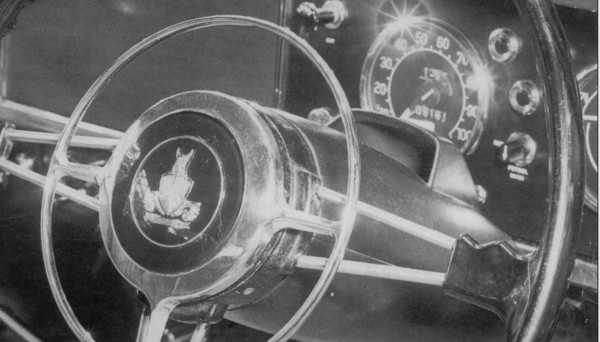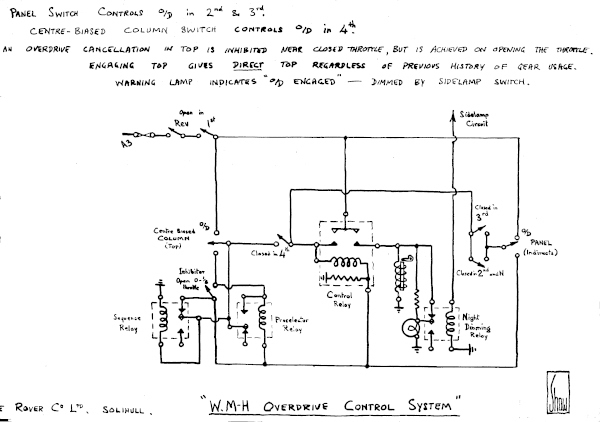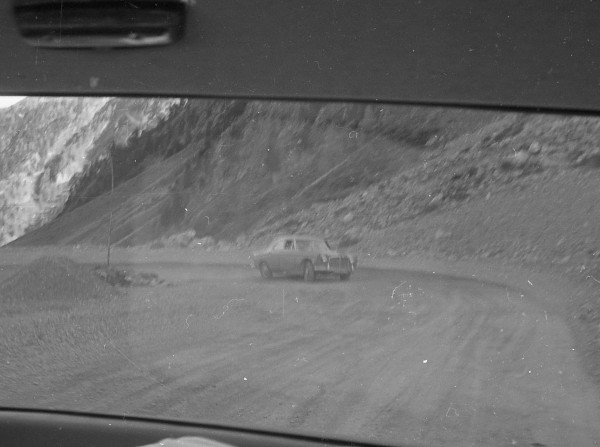Jim Shaw and the Rover P5
The Cabinet Ministers' Car
Odds and Ends
My father, Jim Shaw, had some early involvement in the design of the Rover Three Litre (P5) before the creation of separate P4/P5 Vehicle Project Engineer posts meant that he would have directed more towards P4 development. However the Rover design and development teams formed a close-knit community of car enthusiasts and were led by an equally enthusiastic technical director and chief engineer so there was minimal 'stove-piping' as the Americans call it.
Once P5 had gone into production development work would have been spread out beyond the immediate project. Certainly the first P5 belonging to the Experimental Department turned up at home within a few days of the car's launch.

I remember my father making a binnacle for the P5's steering column-mounted automatic gear lever at home. It was always intended to be fitted to P5, yet here is shown on a P4. Why not a P5 development vehicle? Were there too few? Perhaps this pre-dated P5 launch? I doubt that.
Once UK production was under way some thought would have been given to making a version for export to North America. This is never as simple as just moving the driving controls to the other side. Within Europe it has always been relatively easy and cheap to move cars between nations, 'foreign' cars are familiar everywhere and to some extent the aesthetic demands of the customers and the legal demands of the governments are not too dissimilar. North America is a different matter, even down to the size of the 'license plate'. Another 'home' project for my father as he produced this Ontario-style plate for P5.

Overdrive Control
Rover seems to have had an interest in fitting an overdrive, an auxiliary gearbox, to its vehicles, going back at least to the mid-1940s under WR Boyle. Conventional 'top gear' is a direct drive, i.e. the output shaft turns at the same rate as the input shaft, the effective gearing between engine and road wheels being determined by the 'final drive' gearing in the (usually) rear-axle mounted differential. Once a car is moving at speed, 'cruising', the engine no longer has to provide power for acceleration and it makes sense to reduce engine speed both to improve fuel economy and reduce engine noise. To do this requires a higher gear, 'over' the direct drive.
The de Normanville design of overdrive combined an electrically-controlled, hydraulically-operated clutch and gear train in one unit that could be inserted between an existing gearbox and differential. It was overdrive units of this pattern, manufactured by Laycock, that were considered for use by Rover. As originally conceived the overdrive would be engaged by the driver operating a switch, however in practice it can be more complicated.
At its simplest operation of overdrive is only permitted if the car is in top gear, if the driver changes down then the overdrive would automatically dis-engage. But what if the driver then engages top gear? Should the overdrive re-engage? What should happen if the driver tries to accelerate while overdrive is engaged? The acceleration performance of the vehicle is at its worst in top gear and overdrive reduces that further. Should a 'kick-down' control, (automatic disengagement of overdrive), be provided?
William Martin-Hurst, a director, took a keen interest in the use of overdrive and how to ensure good 'drive-ability', i.e. did the car behave in the way the customer expected and liked? He went so far as to have his personal car fitted without automatic control features so that he could test various operations.
Please order, in addition to the up-rated Laycock overdrive, another unit with the alternative ratio. This is to be fitted to Mr. Martin-Hurst's car (by Service if more convenient).
We are asked to fit the 1963 model control system except that the driver's switch is to be on the gear lever instead of the column and is to operate on all gears (including reverse if this makes the job easier). Ideally, to operate on 2nd, 3rd and top only.
This is to enable Mr. Martin-Hurst to assess his proposed overdrive control system. He appreciates that the overdrive will not take all the torque in 2nd gear.
Please ensure that this work does not put the car out of commission on the 6th of February.
[Memo from P.M. Wilks to R.N. Oxley 31st January 1962]

My father had been involved with the electrical control of gearboxes/overdrives right from the start of his employment with Rover. Working in conjunction with William Martin-Hurst he designed a control system in line with the director's wishes. This became the subject of a joint patent. As with some of the other P5 ideas work on the demonstration rig and the vehicle control pack was carried out at home. (This was probably because, as a home-constructor of radios and televisions, my father had a soldering iron at home but probably not at work).

The scheme that they came up with had a steering column-mounted overdrive selection switch and a panel-mounted mode switch. In some ways this anticipated the multi-mode automatic transmissions fitted to some cars today. The two modes were designated 'Town' and 'Touring', effectively using the overdrive unit to provide an alternate set of intermediate, or 'indirect' (second and third gear) ratios. In the event this arrangement never went into production, only being fitted to William Martin-Hurst's own car, 1275 WD. The handbook is reproduced here.
The scheme used on production cars only allowed overdrive to be selected in top gear using a centre-biased, three-position, steering column-mounted switch. Two switches connected to the throttle mechanism restricted overdrive engagement/disengagment to partial throttle openings only. A 'kick-down' switch automatically disengaged overdrive at full throttle. A single auxilliary relay 'remembered' the overdrive selection state so that overdrive was automatically re-engaged once the throttle returned to the normal running state. This scheme was probably one of the standard schemes developed by Lucas and needed fewer relays and switches, though of course not providing the features desired by Martin-Hurst.
Alpine Brake Trials

By the time the V-8 engine was fitted to P5 (P5B), to produce the 3½ litre my father was Brake Project engineer so would have been involved in specifying the braking system. He was certainly involved in Alpine trials involving both P5B and P6 models on the Stelvio Pass (Switzerland/Italy).
Brake Warning Light
A memo sent out by my father 31 July 1963 on the subject of Brake Warning Lights shows that
'close-knit'
as the engineering teams might be 'joined-up' thinking didn't apply everywhere. Customer complaints
and
comments from within the trade and 'the Rover Company in general' that The handbrake warning
light
is too bright
or The handbrake warning light has been on for 200 miles - the switch needs
adjustment
or
even Do we really need a handbrake warning light - can't we save money by getting rid of it?
dangerously misunderstood its function.
He was critical of the 3-Litre 'Saloon and Coupe Owner's Instruction Manual' as referring to the "warning light, hand brake and brake fluid level", thereby 'putting the cart before the horse'. (The manual for Rover 95/110 was also criticised). The starting procedure for the 3-litre didn't mention the brake warning light at all, that for the Rover 95/110 did but only as a 'brake light'. (The pre-release documentation for the still to be launched P6 was also criticised - perhaps in reviewing that my father had then wondered what the wording in P4 and P5 manuals was?)
He writes:
It cannot be too strongly stressed that the prime function of the "Brake" warning light is to indicate a low brake fluid level early enough to save life, limb and property.
Also, the chief reason for having a handbrake operated switch is to check that the "Brake Fluid Level Warning Light" is operative.
Later on there is an interesting 'human factors' comment that applies as much today:
Since many drivers do not even read the Owner's Manual but rely on learning by experience
the
functions of any new feature, a further difficulty arises. The fact that each time the handbrake
is operated the "Brake" light changes from 'off' to 'on' or vice versa impresses on such
a
'learning' driver the connection between the cause and the effect and this is the little
learning which is a dangerous thing
.
Towards the end of its production life there were concerns that P5B might not comply with future European braking requirement legislation. My father proposed that the Full Power Hydraulic Braking system developed for P8, (recently cancelled), be fitted, though I think he would have expected P5B to be withdrawn before that could happen as it would need to be re-worked to meet anticipated European crash-test requirements, an expense too far.